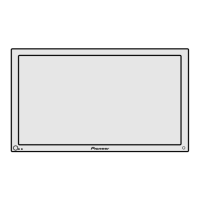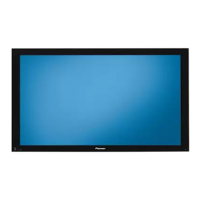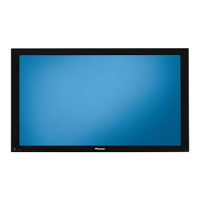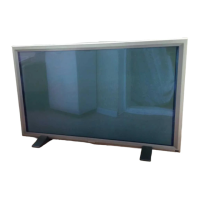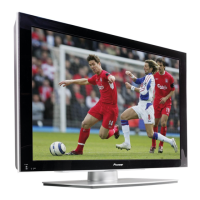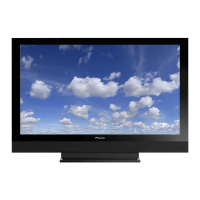Do you have a question about the Pioneer PDP-505HD and is the answer not in the manual?
General safety warnings, cautions, and important notices for user.
Serial number, user rights, FCC compliance, and proper equipment operation.
Detailed instructions on grounding, polarization, and electrical hazard prevention.
Information on when and how to service the unit, including parts.
Advice on placement away from heat sources and ensuring proper ventilation.
Guide on navigating the manual and understanding its structure.
Explains how operations are outlined and referenced in the manual.
Identifies and describes the buttons and indicators on the main unit.
Explains the buttons and operation of the remote control unit.
Details the input/output jacks and control terminals on the unit.
Covers stand/bracket and wall-mount installation procedures.
Details which signals are compatible with each input jack.
Instructions for connecting components to INPUT3 and INPUT4.
Guides for connecting analog RGB sources via G ON SYNC and composite SYNC.
How to connect personal computers and DTV set-top boxes.
Instructions for control cord and power cord connections.
Methods for organizing and routing connected cables.
Procedures for on-screen setup after connecting components to INPUT3/INPUT4.
Selecting signal type and input format for connected components.
Specific on-screen setup for G ON SYNC connections.
How to switch between connected video sources.
Creating still images and confirming current display settings.
Manually selecting various screen aspect ratios for optimal viewing.
Using AUTO SCREEN to automatically adjust picture size based on signal.
Adjusting the vertical position (V.POSITION) of the screen image.
How the unit automatically selects screen size based on input signal type.
Configuring the unit to enter standby mode automatically.
Assigning custom labels to input sources for easier identification.
Navigating and understanding the structure of the on-screen menus.
Modifying picture settings and selecting programmed quality presets.
Storing custom picture adjustments in the USER mode.
Detailed explanation of picture adjustment options like CONTRAST, COLOR, etc.
Reducing blur for fast-moving images using 3D Y/C LEVEL.
Reducing digital noise in video images via 3D NR LEVEL.
Setting the screen's color temperature (NEWS, LIVE, STD, FILM, B&W).
Optimizing picture for film content by converting to progressive video.
Enhancing image clarity in bright environments with HIGH CONTRAST.
Adjusting PC image brightness using the ABL function.
Adjusting screen position, clock frequency, and phase.
Setting up the remote to control other manufacturers' devices via presets.
Teaching the remote to operate devices by learning their signals.
Details on setting buttons, mode switch, and receiver controls.
Operating the VCR using specific remote control buttons.
Operating Cable and Satellite tuners with the remote.
Specific buttons for controlling satellite tuners.
Buttons for operating DTV set-top boxes.
Restoring the unit's settings to their original factory state.
Procedures for cleaning the display, remote, and vents.
Inserting batteries and understanding the remote's operating range.
Identifying and resolving general operational issues and malfunctions.
Issues often mistaken for malfunctions and additional operational cautions.
Explains panel protection features and self-diagnosis messages.
Lists detailed technical data for the display unit.
Table showing screen size compatibility for INPUT1 and INPUT2.
Table showing screen size compatibility for INPUT3 and INPUT4.
Table detailing PC resolutions, frequencies, and screen size compatibility.
Pin assignments for the Mini D-Sub 15-pin connector on INPUT 4.
Definitions of technical terms like Aspect Ratio, S-Video, VGA, XGA, etc.
General safety warnings, cautions, and important notices for user.
Serial number, user rights, FCC compliance, and proper equipment operation.
Detailed instructions on grounding, polarization, and electrical hazard prevention.
Information on when and how to service the unit, including parts.
Advice on placement away from heat sources and ensuring proper ventilation.
Guide on navigating the manual and understanding its structure.
Explains how operations are outlined and referenced in the manual.
Identifies and describes the buttons and indicators on the main unit.
Explains the buttons and operation of the remote control unit.
Details the input/output jacks and control terminals on the unit.
Covers stand/bracket and wall-mount installation procedures.
Details which signals are compatible with each input jack.
Instructions for connecting components to INPUT3 and INPUT4.
Guides for connecting analog RGB sources via G ON SYNC and composite SYNC.
How to connect personal computers and DTV set-top boxes.
Instructions for control cord and power cord connections.
Methods for organizing and routing connected cables.
Procedures for on-screen setup after connecting components to INPUT3/INPUT4.
Selecting signal type and input format for connected components.
Specific on-screen setup for G ON SYNC connections.
How to switch between connected video sources.
Creating still images and confirming current display settings.
Manually selecting various screen aspect ratios for optimal viewing.
Using AUTO SCREEN to automatically adjust picture size based on signal.
Adjusting the vertical position (V.POSITION) of the screen image.
How the unit automatically selects screen size based on input signal type.
Configuring the unit to enter standby mode automatically.
Assigning custom labels to input sources for easier identification.
Navigating and understanding the structure of the on-screen menus.
Modifying picture settings and selecting programmed quality presets.
Storing custom picture adjustments in the USER mode.
Detailed explanation of picture adjustment options like CONTRAST, COLOR, etc.
Reducing blur for fast-moving images using 3D Y/C LEVEL.
Reducing digital noise in video images via 3D NR LEVEL.
Setting the screen's color temperature (NEWS, LIVE, STD, FILM, B&W).
Optimizing picture for film content by converting to progressive video.
Enhancing image clarity in bright environments with HIGH CONTRAST.
Adjusting PC image brightness using the ABL function.
Adjusting screen position, clock frequency, and phase.
Setting up the remote to control other manufacturers' devices via presets.
Teaching the remote to operate devices by learning their signals.
Details on setting buttons, mode switch, and receiver controls.
Operating the VCR using specific remote control buttons.
Operating Cable and Satellite tuners with the remote.
Specific buttons for controlling satellite tuners.
Buttons for operating DTV set-top boxes.
Restoring the unit's settings to their original factory state.
Procedures for cleaning the display, remote, and vents.
Inserting batteries and understanding the remote's operating range.
Identifying and resolving general operational issues and malfunctions.
Issues often mistaken for malfunctions and additional operational cautions.
Explains panel protection features and self-diagnosis messages.
Lists detailed technical data for the display unit.
Table showing screen size compatibility for INPUT1 and INPUT2.
Table showing screen size compatibility for INPUT3 and INPUT4.
Table detailing PC resolutions, frequencies, and screen size compatibility.
Pin assignments for the Mini D-Sub 15-pin connector on INPUT 4.
Definitions of technical terms like Aspect Ratio, S-Video, VGA, XGA, etc.
| Screen Size | 50 inches |
|---|---|
| Display Type | Plasma |
| Aspect Ratio | 16:9 |
| Brightness | 1000 cd/m² |
| Contrast Ratio | 3000:1 |
| HDMI Inputs | 2 |
| Component Video Inputs | 2 |
| Composite Video Inputs | 1 |
| S-Video Inputs | 1 |
| Viewing Angle | 160 degrees |
| Response Time | 0.001 ms |
| Inputs | HDMI, Component, Composite, S-Video |
| Resolution | 1280 x 768 |

